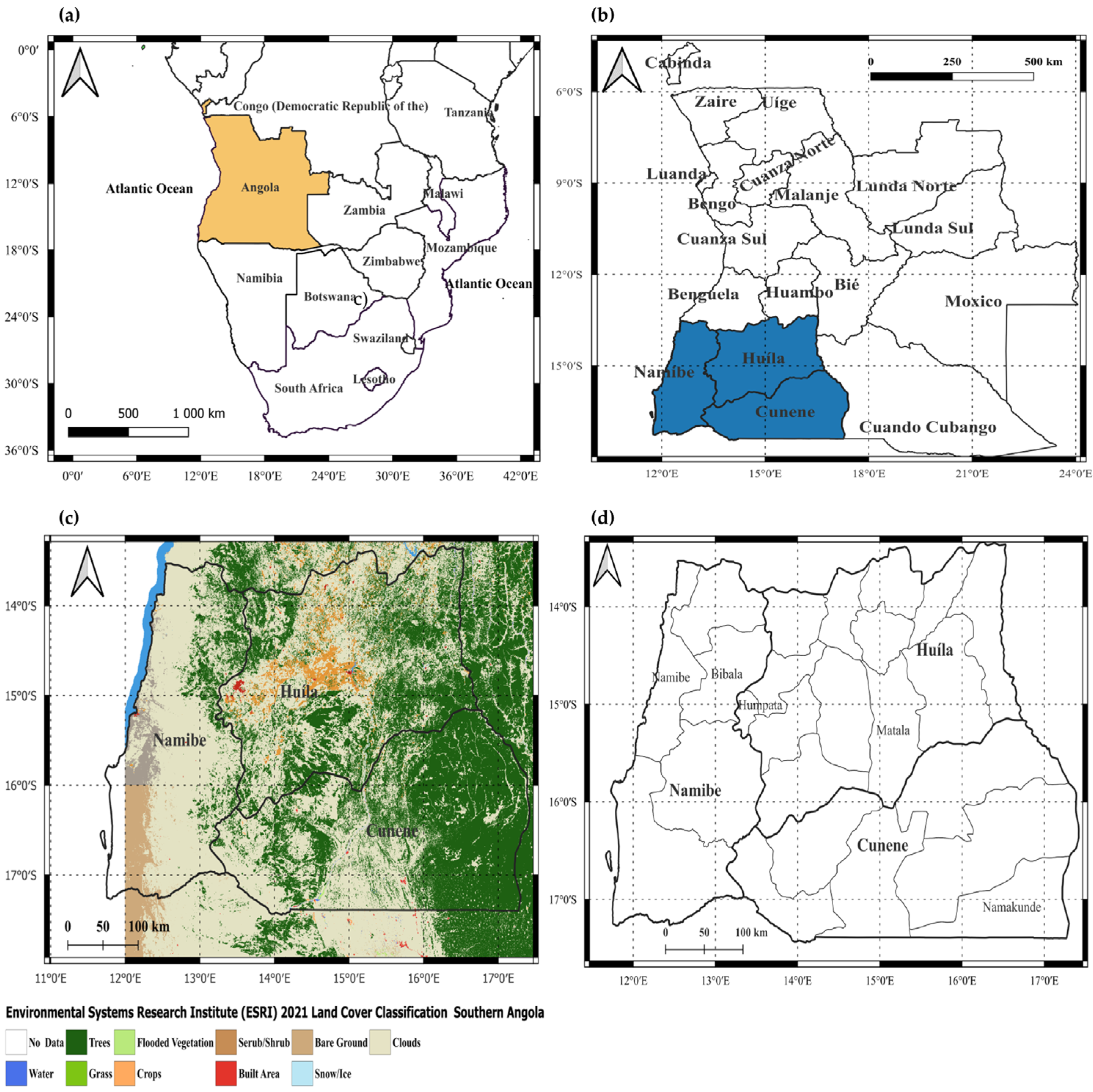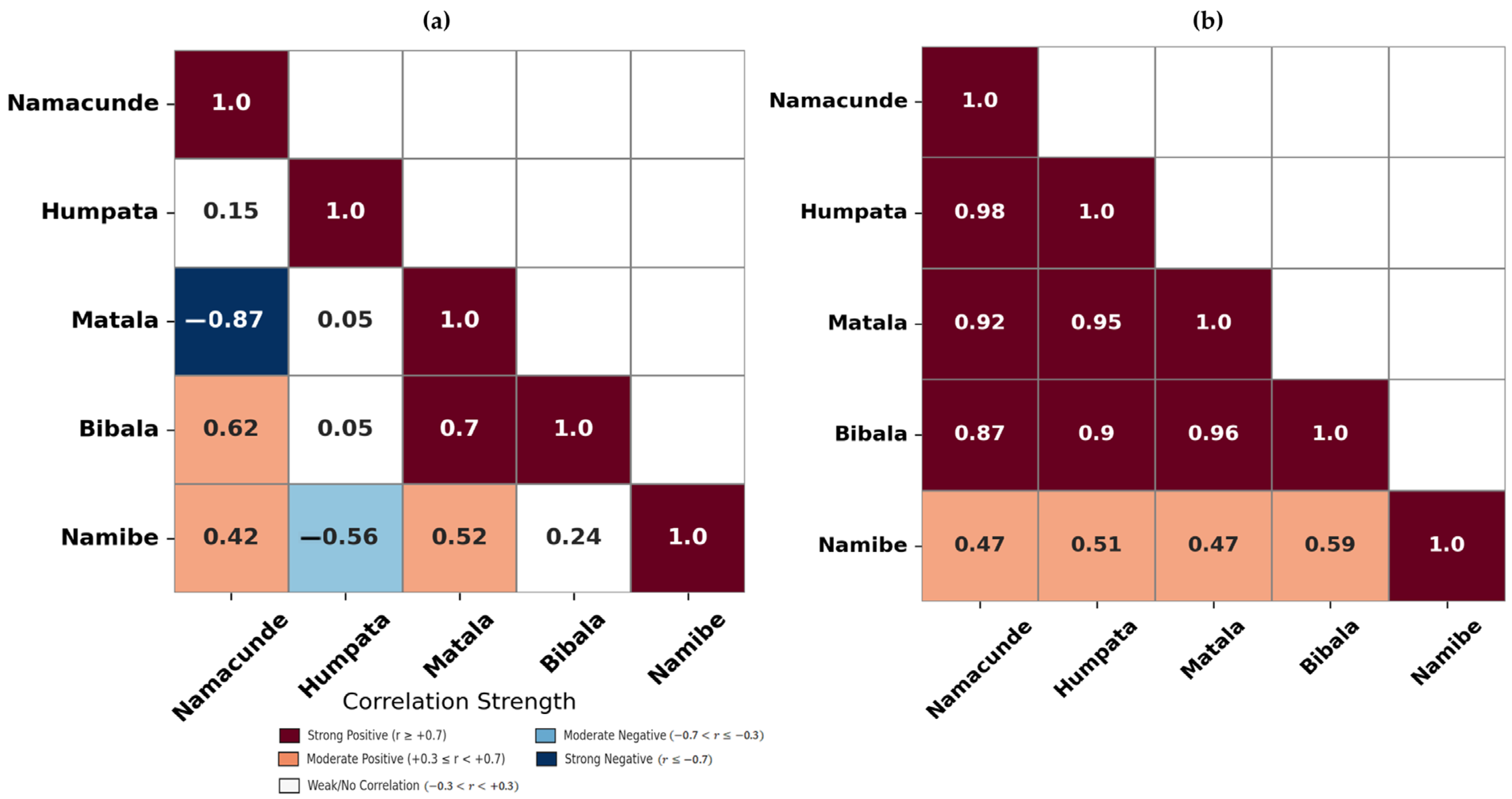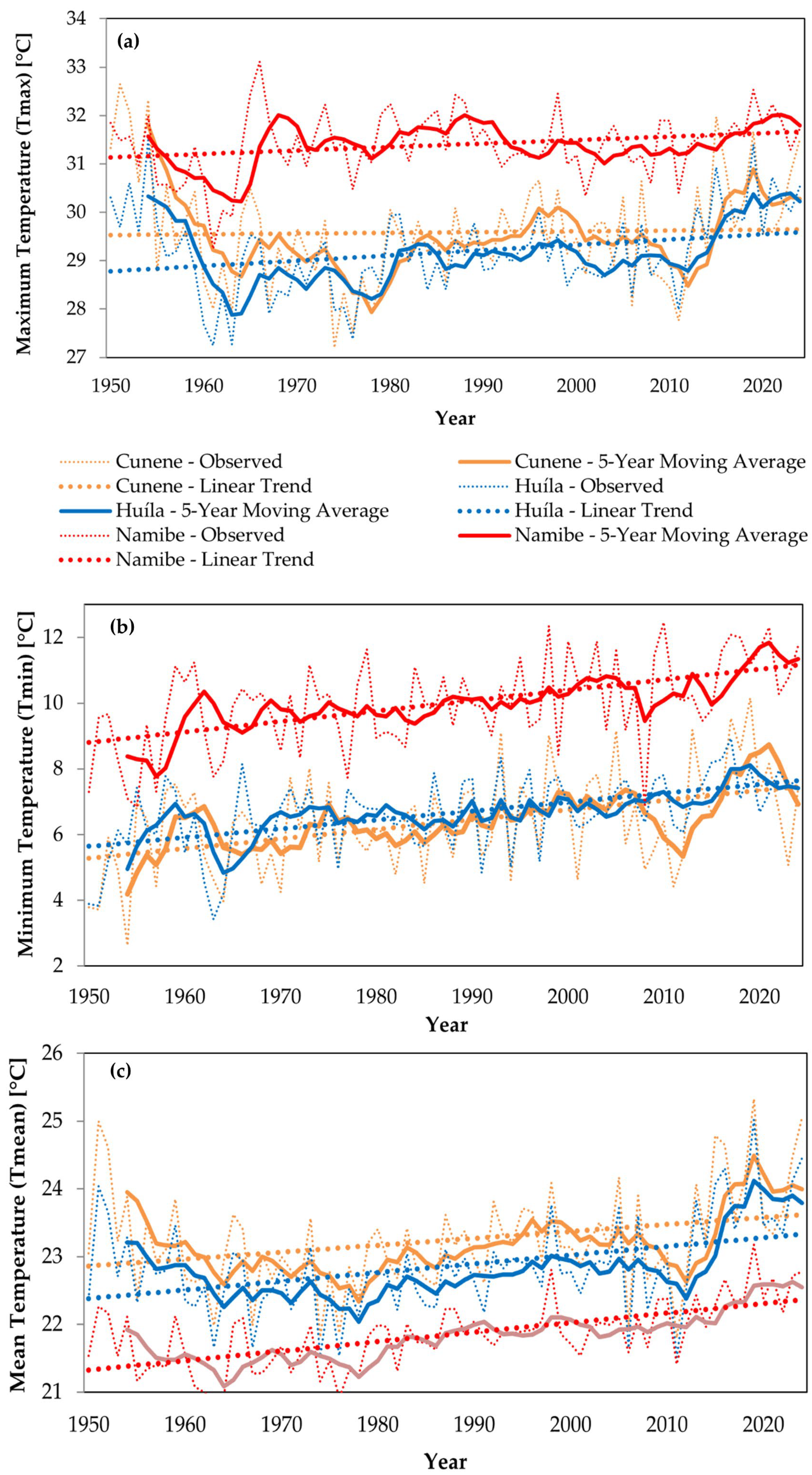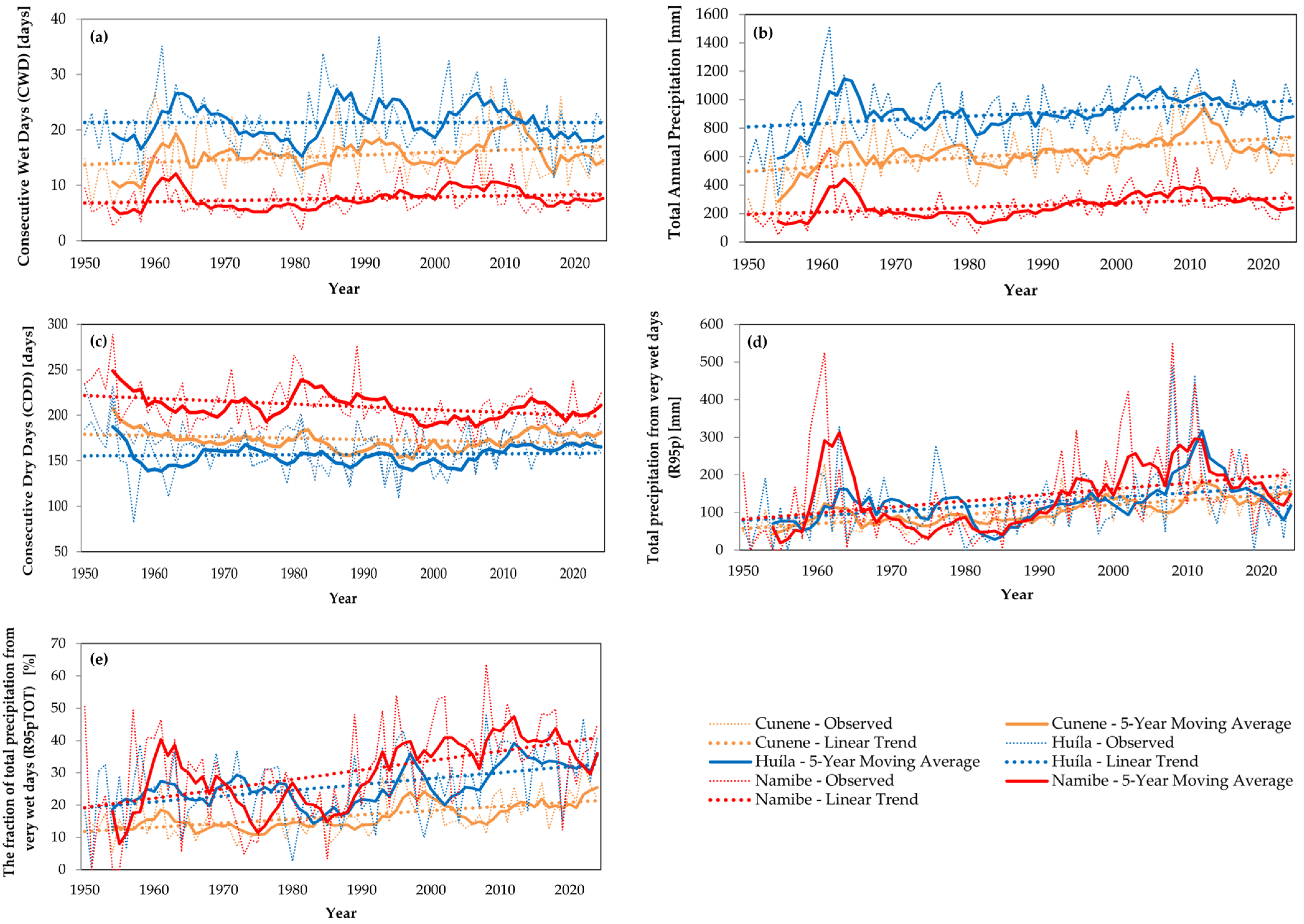Long-Term Climate Trends in Southern Angola and Possible Implications in Agriculture
Abstract
1. Introduction
2. Materials and Methods
2.1. Study Area Characterisation

2.2. Global Reanalysed Data and Local Observational Data
- Annual means of daily maximum temperature (Tmax);
- Annual means of daily minimum temperature (Tmin);
- Annual means of daily mean temperature (Tmean); and
- Annual precipitation totals.
- The total accumulated precipitation from all wet days (≥1 mm) over a given period (PRCPTOT);
- The total precipitation amount from very wet days (R95p);
- The percentage of total precipitation contributed by very wet days, defined as days with daily precipitation above the 95th percentile of a reference period (R95pTOT);
- The maximum number of consecutive days with precipitation below 1 mm (CDD); and
- The maximum number of consecutive days with precipitation equal to or above 1 mm (CWD).
2.3. Methodology
2.3.1. Methodological Framework and Technical Roadmap
2.3.2. Statistical Metrics for Model Validation
- observed value at time ;
- : reanalysis (ERA5-Land) value at time ;
- and are the means of observed and ERA5-Land values, respectively;
- : number of data pairs.
2.3.3. Linear Regression
2.3.4. Mann–Kendall’s Trend Test
2.3.5. Sen’s Slope Estimate
3. Results
3.1. Validation of ERA5-Land Data Using Observational Records
3.2. Climate Trend Analysis
3.2.1. Temperature Trends
3.2.2. Precipitation Trends
3.3. Full Climate-Crop Statistical Analysis for Angola (1961–2023)
3.3.1. Impact of Isolated Climate Variables on Crop Yield (2000–2023)
3.3.2. Statistical Significance of Contingency Patterns
- -
- Temperature vs. Yield: p-value = 1.51 × 10−17 (highly significant)
- -
- Precipitation vs. Yield: p-value = 0.00041 (statistically significant)
4. Discussion
5. Conclusions
Supplementary Materials
Author Contributions
Funding
Data Availability Statement
Acknowledgments
Conflicts of Interest
Abbreviations
| CDD | consecutive dry days |
| CDO | climate data operators |
| CWD | consecutive wet days |
| ECMWF | European Centre for Medium-Range Weather Forecasts |
| ERA5-Land | fifth-generation ECMWF atmospheric reanalysis |
| ERA5-Land | high-resolution land component of ERA5-Land |
| ETCCDI | Expert Team on Climate Change Detection and Indices |
| FCT | Foundation for Science and Technology |
| MK | Mann–Kendall |
| PRCPTOT | total annual precipitation on days with ≥ 1 mm |
| QGIS | Quantum Geographic Information System |
| R95p | very wet days (total precipitation from days exceeding the 95th percentile threshold) |
| R95ptot | the fraction of total precipitation from very wet day |
| SASSCAL | Southern African Science Service Centre for Climate Change and Adaptive Land Management |
| Tmax | daily maximum temperature |
| Tmean | daily mean temperature |
| Tmin | daily minimum temperature |
References
- IPCC. Climate Change 2023 Synthesis Report; IPCC: Geneva, Switzerland, 2023; Volume 13, pp. 35–115. [Google Scholar]
- Nhemachena, C.C.R.; Nhamo, L.; Matchaya, G.; Nhemachena, C.C.R.; Muchara, B.; Karuaihe, S.T.; Mpandeli, S. Climate change impacts on water and agriculture sectors in southern africa: Threats and opportunities for sustainable development. Water 2020, 12, 2673. [Google Scholar] [CrossRef]
- Nooni, I.K.; Hagan, D.F.T.; Ullah, W.; Lu, J.; Li, S.; Prempeh, N.A.; Gnitou, G.T.; Sian, K.T.C.L.K. Projections of Drought Characteristics Based on the CNRM-CM6 Model over Africa. Agriculture 2022, 12, 495. [Google Scholar] [CrossRef]
- Girdler-Brown, B. Eastern and southern Africa. Int. Migr. 1998, 36, 513–551. [Google Scholar] [CrossRef]
- Brown, M.E.; de Beurs, K.; Vrieling, A. The response of African land surface phenology to large scale climate oscillations. Remote Sens. Environ. 2010, 114, 2286–2296. [Google Scholar] [CrossRef]
- Tadross, M.; Suarez, P.; Lotsch, A.; Hachigonta, S.; Mdoka, M.; Unganai, L.; Lucio, F.; Kamdonyo, D.; Muchinda, M. Growing-season rainfall and scenarios of future change in southeast Africa: Implications for cultivating maize. Clim. Res. 2009, 40, 147–161. [Google Scholar] [CrossRef]
- Pinto, I.; de Perez, E.C.; Jaime, C.; Wolski, P.; van Aardenne, L.; Jjemba, E.; Suidman, J.; Serrat-Capdevila, A.; Tall, A. Climate change projections from a multi-model ensemble of CORDEX and CMIPs over Angola. Environ. Res. Clim. 2023, 2, 035007. [Google Scholar] [CrossRef]
- Thomas, N.; Nigam, S. Twentieth-century climate change over Africa: Seasonal hydroclimate trends and sahara desert expansion. J. Clim. 2018, 31, 3349–3370. [Google Scholar] [CrossRef]
- Group, T.W.B. Angola Country Climate and Development Report. 2022. Available online: http://hdl.handle.net/10400.26/42558 (accessed on 27 May 2025).
- Mateus, N.P.A.; Marengo, J.A.; Cunha, A.P.M.A.; Diogo, A.M.; António, J.F. Spatial–temporal characterization of droughts in Angola. Int. J. Climatol. 2024, 44, 370–392. [Google Scholar] [CrossRef]
- Chivangulula, F.M.; Amraoui, M. The Drought Regime in Southern Africa: Long-Term Space-Time Distribution of Main Drought Descriptors. Climate 2024, 12, 221. [Google Scholar] [CrossRef]
- Correia, C.D.N.; Amraoui, M.; Santos, A. Analysis of the Impacts of Climate Change on Agriculture in Angola: Systematic Literature Review. Agronomy 2024, 14, 783. [Google Scholar] [CrossRef]
- The Southern Africa Drought Resilience Initiative, S.A.D.R.I.A. Drought Resilience Profiles | Angola Drought: Historical and Future. South Africa. 2021, pp. 1–9. Available online: https://www.ciwaprogram.org/wp-content/uploads/SADRI_Drought_Resilience_Profile_Angola.pdf (accessed on 27 May 2025).
- CIMA Research Foundation; UNDRR. Disaster Risk Profile of Angola. Nairobi: UNDRR and CIMA Research Foundation. 2019, pp. 1–52. Available online: https://www.undrr.org/media/86920/download (accessed on 27 May 2025).
- Lourenco, M.; Woodborne, S.; Fitchett, J.M. Drought history and vegetation response in the Angolan Highlands. Theor. Appl. Climatol. 2023, 151, 115–131. [Google Scholar] [CrossRef]
- Correia, C.D.N.; Amraoui, M.; Santos, J.A. Assessment of Climate Change in Angola and Potential Impacts on Agriculture. Climate 2025, 13, 12. [Google Scholar] [CrossRef]
- MINAGRIP Relatório de Resultados da Campanha Agrícola 2019/2020. 2020. Available online: https://rvaaatlas.sadc.int/media/352be47c-048c-40cc-8567-74d40ec147aa/5b3a7c6a-7572-4f3a-be0d-406bd7356e27/RCA%202019-2020-FINAL.pdf (accessed on 27 May 2025).
- Brian, H.; Vladimir, R.; Fernanda, L.; Nuno, A. Biodiversidade de Angola. 2021. Available online: https://www.unescolifeonland.com/fotos/editor2/BiodiversidadeAngola_.pdf (accessed on 27 May 2025).
- Gadedjisso-Tossou, A.; Adjegan, K.I.; Kablan, A.K.M. Rainfall and Temperature Trend Analysis by Mann—Kendall Test and Significance for Rainfed Cereal Yields in Northern Togo. Science 2021, 3, 17. [Google Scholar] [CrossRef]
- Alahacoon, N.; Edirisinghe, M.; Simwanda, M.; Perera, E.N.C.; Nyirenda, V.R.; Ranagalage, M. Rainfall variability and trends over the african continent using tamsat data (1983–2020): Towards climate change resilience and adaptation. Remote Sens. 2022, 14, 96. [Google Scholar] [CrossRef]
- Meshram, S.G.; Kahya, E.; Meshram, C.; Ghorbani, M.A.; Ambade, B.; Mirabbasi, R. Long-term temperature trend analysis associated with agriculture crops. Theor. Appl. Climatol. 2020, 140, 1139–1159. [Google Scholar] [CrossRef]
- Caloiero, T.; Guagliardi, I. Climate change assessment: Seasonal and annual temperature analysis trends in the Sardinia region (Italy). Arab. J. Geosci. 2021, 14, 1–10. [Google Scholar] [CrossRef]
- Sakalis, V.D. Trend analysis of the annual and seasonal temperature series in the Eastern Coast of Peloponnese (Greece). Arab. J. Geosci. 2023, 16, 1–17. [Google Scholar] [CrossRef]
- Li, C.; Camac, J.; Robinson, A.; Kompas, T. Predicting changes in agricultural yields under climate change scenarios and their implications for global food security. Sci. Rep. 2025, 15, 2858. [Google Scholar] [CrossRef]
- Schmidt, M.; Felsche, E. The effect of climate change on crop yield anomaly in Europe. Clim. Resil. Sustain. 2024, 3, 1–13. [Google Scholar] [CrossRef]
- Fisher, A.; Hanemann, M.; Roberts, M.; Schlenker, W. Estimating the Effect of Climate Change on Crop Yields and Farmland Values: The Importance of Extreme Temperatures. NCEE Presentation, U.S. Environmental Protection Agency; 12 February 2008. Available online: https://19january2021snapshot.epa.gov/sites/static/files/2014-11/documents/estimating-the_effect_of_climate_change_on_crop_yields_and_farmland_values.pdf (accessed on 27 May 2025).
- Zhu, X.; Troy, T.J. Agriculturally Relevant Climate Extremes and Their Trends in the World’s Major Growing Regions. Earth’s Futur. 2018, 6, 656–672. [Google Scholar] [CrossRef]
- Biastoch, A.; Rühs, S.; Ivanciu, I.; Schwarzkopf, F.U.; Veitch, J.; Reason, C.; Zorita, E.; Tim, N.; Hünicke, B.; Vafeidis, A.T.; et al. The Agulhas Current System as an Important Driver for Oceanic and Terrestrial Climate. In Sustainability of Southern African Ecosystems under Global Change; Springer: Cham, Switzerland, 2024; pp. 191–220. [Google Scholar] [CrossRef]
- Utilizada, M. Relatório de Consultoria sobre: Assistência Técnica para a Realização do Estudo de Diagnóstico “Sementes para a Agricultura Familiar Incluindo as Práticas Tradicionais de Produção, Conservação e Armazenamento” no Âmbito do Projeto FRESAN—Fortalecimento da Resiliência e da Segurança Alimentar e Nutricional em Angola (FED/2017/389-710) . 2017, pp. 1–11. Available online: https://fresan-angola.org/wp-content/uploads/2022/08/AP2-A.-1.2.2-a-Relatório-Final_SEMENTES-PARA-A-AGRICULTURA-FAMILIAR-INCLUINDO-AS-PRÁTICAS.pdf (accessed on 27 May 2025).
- Karra, K.; Kontgis, C.; Statman-Weil, Z.; Mazzariello, J.C.; Mathis, M.; Brumby, S.P. Global land use/land cover with Sentinel-2 and deep learning. In Proceedings of the IGARSS 2021—2021 IEEE International Geoscience and Remote Sensing Symposium, Brussels, Belgium, 11–16 July 2021. [Google Scholar]
- Muñoz Sabater, J. ERA5-Land Hourly Data from 1950 to Present. Copernicus ECMWF: Reading, UK, 2019. [Google Scholar] [CrossRef]
- Silva; de Lima, E.H.Z. Agroclimático e Potencial de Rendimento da Soja na Região do SEALBA; RIUFAL: Simões, Brazil, 2022; Volume 9, pp. 356–363. Available online: https://www.repositorio.ufal.br/jspui/handle/123456789/12258 (accessed on 27 May 2025).
- Muñoz-Sabater, J.; Dutra, E.; Agustí-Panareda, A.; Albergel, C.; Arduini, G.; Balsamo, G.; Boussetta, S.; Choulga, M.; Harrigan, S.; Hersbach, H.; et al. ERA5-Land: A state-of-the-art global reanalysis dataset for land applications. Earth Syst. Sci. Data 2021, 13, 4349–4383. [Google Scholar] [CrossRef]
- Kaspar, F.; Helmschrot, J.; Mhanda, A.; Butale, M.; de Clercq, W.; Kanyanga, J.K.; Neto, F.O.S.; Kruger, S.; Matsheka, M.C.; Muche, G.; et al. The SASSCAL contribution to climate observation, climate data management and data rescue in Southern Africa. Adv. Sci. Res. 2015, 12, 171–177. [Google Scholar] [CrossRef]
- Carvalho, S.C.P.; Santos, F.D.; Pulquério, M. Climate change scenarios for Angola: An analysis of precipitation and temperature projections using four RCMs. Int. J. Climatol. 2017, 37, 3398–3412. [Google Scholar] [CrossRef]
- Intergovernmental Panel on Climate Change (IPCC). Climate Change 2021—The Physical Science Basis; Cambridge University Press: Cambridge, UK, 2023. [Google Scholar] [CrossRef]
- FAOSTAT Statistical Database. Food and Agriculture Organization of the United Nations. 2024. Available online: https://www.fao.org/faostat (accessed on 30 June 2025).
- Mayo, R.; Division, S. FAOSTAT2 Project: Revising the Conceptual Statistical Frameworks, Underlying Statistical Methodologies, Database System and Processes. 2024. Available online: http://www.fao.org/faostat/countrystat_en.asp (accessed on 30 June 2025).
- Yuemei, H.; Xiaoqin, Z.; Jianguo, S.; Jina, N. Conduction between left superior pulmonary vein and left atria and atria fibrillation under cervical vagal trunk stimulation. Colomb. Med. 2008, 39, 227–234. [Google Scholar] [CrossRef]
- Tarek, M.; Brissette, F.P.; Arsenault, R. Evaluation of the ERA5 reanalysis as a potential reference dataset for hydrological modelling over North America. Hydrol. Earth Syst. Sci. 2020, 24, 2527–2544. [Google Scholar] [CrossRef]
- Montgomery, C.D.; Peck, A.E.; Vining, G.G. Introducing To Linear Regression Analysis, 5th ed.; John Wiley and Sons: Hoboken, NJ, USA, 2012; p. 642. [Google Scholar]
- Wang, W.; Chen, X.; Shi, P.; van Gelder, P.H.A.J.M.; Corzo, G. Extreme precipitation and extreme streamflow in the Dongjiang River Basin in southern China To cite this version: HAL Id: Hal-00298863 Extreme precipitation and extreme streamflow in the Dongjiang River Basin in southern China. Hydrol. Earth Syst. Sci. Discuss. 2008, 4, 2323–2360. [Google Scholar]
- Ali, R.; Kuriqi, A.; Abubaker, S.; Kisi, O. Long-term trends and seasonality detection of the observed flow in Yangtze River using Mann-Kendall and Sen’s innovative trend method. Water 2019, 11, 1855. [Google Scholar] [CrossRef]
- Gadgil, A.; Dhorde, A. Temperature trends in twentieth century at Pune, India. Atmos. Environ. 2005, 39, 6550–6556. [Google Scholar] [CrossRef]
- Frimpong, B.F.; Koranteng, A.; Molkenthin, F. Analysis of temperature variability utilising Mann–Kendall and Sen’s slope estimator tests in the Accra and Kumasi Metropolises in Ghana. Environ. Syst. Res. 2022, 11, 1–13. [Google Scholar] [CrossRef]
- Akhundzadah, N.A. Analyzing Temperature, Precipitation, and River Discharge Trends in Afghanistan’s Main River Basins Using Innovative Trend Analysis, Mann–Kendall, and Sen’s Slope Methods. Climate 2024, 12, 196. [Google Scholar] [CrossRef]
- Hansen, J.; Ruedy, R.; Sato, M.; Lo, K. Global surface temperature change. Rev. Geophys. 2010, 48, 1–29. [Google Scholar] [CrossRef]
- Manton, M.J.; Della-Marta, P.M.; Haylock, M.R.; Hennessy, K.J.; Nicholls, N.; Chambers, L.E.; Collins, D.; Daw, G.; Finet, A.; Gunawan, D.; et al. Trends in extreme daily rainfall and temperature in southeast Asia and the south Pacific: 1961–1998. Int. J. Climatol. 2001, 21, 269–284. [Google Scholar] [CrossRef]
- Hersbach, H.; Bell, B.; Berrisford, P.; Hirahara, S.; Horányi, A.; Muñoz-Sabater, J.; Nicolas, J.; Peubey, C.; Radu, R.; Schepers, D.; et al. The ERA5 global reanalysis. Q. J. R. Meteorol. Soc. 2020, 146, 1999–2049. [Google Scholar] [CrossRef]
- Bojinski, S.; Verstraete, M.; Peterson, T.C.; Richter, C.; Simmons, A.; Zemp, M. The concept of essential climate variables in support of climate research, applications, and policy. Bull. Am. Meteorol. Soc. 2014, 95, 1431–1443. [Google Scholar] [CrossRef]
- Pereira, C.A.; Martins, J.P.; Fink, A.H.; Pinto, J.G.; Ramos, A.M. Drivers of seasonal rainfall variability over the Angolan and Namibian plateaus. Int J Climatol. 2024, 44, 3706–3725. [Google Scholar] [CrossRef]
- Wood, R. Stratocumulus clouds. Mon. Weather. Rev. 2012, 140, 2373–2423. [Google Scholar] [CrossRef]
- Vizy, E.K.; Cook, K.H.; Sun, X. Decadal change of the south Atlantic ocean Angola–Benguela frontal zone since 1980. Clim. Dyn. 2018, 51, 3251–3273. [Google Scholar] [CrossRef]
- Majumder, S.; Schmid, C. A study of the variability in the Benguela Current volume transport. Ocean. Sci. 2018, 14, 273–283. [Google Scholar] [CrossRef]
- NAPA Tuvalu. Angola’s National Adaptation Programme of Action: Under the auspices of the United Nations Framework Convention on Climate Change. Dep. Environ. 2007, 55, 19. Available online: https://unfccc.int/resource/docs/napa/ago01.pdf (accessed on 30 June 2025).
- Moreno, A.; Hasenauer, H. Spatial downscaling of European climate data. Int. J. Climatol. 2016, 36, 1444–1458. [Google Scholar] [CrossRef]
- Dawson, B.; Spannagle, M. Intergovernmental Panel on Climate Change (IPCC). In The Complete Guide to Climate Change, 1st ed.; Routledge: Oxfordshire, UK, 2020. [Google Scholar] [CrossRef]
- Zhang, X.; Alexander, L.; Hegerl, G.C.; Jones, P.; Tank, A.K.; Peterson, T.C.; Trewin, B.; Zwiers, F.W. Indices for monitoring changes in extremes based on daily temperature and precipitation data. Wiley Interdiscip. Rev. Clim. Change 2011, 2, 851–870. [Google Scholar] [CrossRef]
- Coelho, E.d.S.R. Eventos Climáticos de Seca Prolongada em Angola. Avaliação de Necessidades Específicas de Operações de Emergência e Socorro. 2020. Available online: https://comum.rcaap.pt/entities/publication/1b3d78fa-8bda-4b70-a8f6-445af09f5bdb/full (accessed on 27 May 2025).
- Chivangulula, F.M.; Amraoui, M.; Pereira, M.G. The Drought Regime in Southern Africa: A Systematic Review. Climate 2023, 11, 147. [Google Scholar] [CrossRef]
- Nhamo, L.; Mabhaudhi, T.; Modi, A.T. Preparedness or repeated short-term relief aid? Building drought resilience through early warning in southern africa. Water SA 2019, 45, 75–85. [Google Scholar] [CrossRef]
- Dosio, A.; Jones, R.G.; Jack, C.; Lennard, C.; Nikulin, G.; Hewitson, B. What can we know about future precipitation in Africa? Robustness, significance and added value of projections from a large ensemble of regional climate models. Clim. Dyn. 2019, 53, 5833–5858. [Google Scholar] [CrossRef]
- Dosio, A.; Jury, M.W.; Almazroui, M.; Ashfaq, M.; Diallo, I.; Engelbrecht, F.A.; Klutse, N.A.B.; Lennard, C.; Pinto, I.; Sylla, M.B.; et al. Projected future daily characteristics of African precipitation based on global (CMIP5, CMIP6) and regional (CORDEX, CORDEX-CORE) climate models. Clim. Dyn. 2021, 57, 3135–3158. [Google Scholar] [CrossRef]
- Lal, R. Soil degradation by erosion. L Degrad. Dev. 2001, 12, 519–539. [Google Scholar] [CrossRef]
- Sitienei, B.J.; Juma, S.G.; Opere, E. On the use of regression models to predict tea crop yield responses to climate change: A case of Nandi East, Sub-County of Nandi County, Kenya. Climate 2017, 5, 54. [Google Scholar] [CrossRef]
- Lobell, D.B.; Schlenker, W.; Costa-Roberts, J. Climate trends and global crop production since 1980. Science 2011, 333, 616–620. [Google Scholar] [CrossRef]
- Schlenker, W.; Lobell, D.B. Robust negative impacts of climate change on African agriculture. Environ. Res. Lett. 2010, 5, 014010. [Google Scholar] [CrossRef]
- Parmesan, T.; Morecroft, C. Impacts, Adaptation, and Vulnerability; Working Group II Contribution to the IPCC Sixth Assessment Report of the Intergovernmental Panel on Climate, Change; Roberts, D.C.O., Tignor, M., Poloczanska, E.S., Mintenbeck, K., Ale, A., Eds.; Cambridge University Press: Cambridge, UK, 2023. [Google Scholar] [CrossRef]
- Aryal, J.P.; Sapkota, T.B.; Rahut, D.B.; Marenya, P.; Stirling, C.M. Climate risks and adaptation strategies of farmers in East Africa and South Asia. Sci. Rep. 2021, 11, 1–14. [Google Scholar] [CrossRef]
- Lourenco, M.; Woodborne, S. Defining the Angolan Highlands Water Tower, a 40 plus-year precipitation budget of the headwater catchments of the Okavango Delta. Environ. Monit. Assess 2023, 195, 1–16. [Google Scholar] [CrossRef]
- Giorgi, F.; Lionello, P. Climate change projections for the Mediterranean region. Glob. Planet. Change 2008, 63, 90–104. [Google Scholar] [CrossRef]
- Faye, D.; Kaly, F.; Dieng, A.L.; Wane, D.; Fall, C.M.N.; Mignot, J.; Gaye, A.T. Regionalization of the Onset and Offset of the Rainy Season in Senegal Using Kohonen Self-Organizing Maps. Atmosphere 2024, 15, 378. [Google Scholar] [CrossRef]





| Province | Linear Trend | R2 (%) | p-Value (Linear) | Sen’s Slope | p-Value | Trend Significance |
|---|---|---|---|---|---|---|
| Cunene | 0.002 | 0.166 | 0.729 | 0.005 | 0.470 | No trend |
| Huíla | 0.013 | 12.626 | 0.002 | 0.017 | 0.000 | Increasing |
| Namibe | 0.008 | 5.849 | 0.037 | 0.008 | 0.026 | Increasing |
| Province | Linear Trend | R2 (%) | p-Value (Linear) | Sen’s Slope | p-Value | Trend Significance |
|---|---|---|---|---|---|---|
| Cunene | 0.030 | 17.626 | 0.000 | 0.028 | 0.001 | Increasing |
| Huíla | 0.027 | 26.127 | 0.000 | 0.025 | 0.000 | Increasing |
| Namibe | 0.032 | 25.806 | 0.000 | 0.032 | 0.000 | Increasing |
| Province | Linear Trend | R2 (%) | p-Value (Linear) | Sen’s Slope | p-Value | Trend Significance |
|---|---|---|---|---|---|---|
| Cunene | 0.009 | 4.574 | 0.065 | 0.012 | 0.022 | Increasing |
| Huíla | 0.014 | 27.768 | 0.000 | 0.016 | 0.000 | Increasing |
| Namibe | 0.011 | 16.360 | 0.000 | 0.012 | 0.000 | Increasing |
| Index Name | Abbreviation | Description |
|---|---|---|
| Consecutive Dry Days | CDD | Maximum number of consecutive days with precipitation < 1 mm |
| Consecutive Wet Days | CWD | Maximum number of consecutive days with precipitation ≥ 1 mm |
| Total Annual Precipitation | PRCPTOT | Total annual precipitation on days with≥ 1 mm |
| Very Wet Days | R95p | Very wet days concerning the 95th percentile of reference period |
| Very Wet Days (%) | R95pTOT | The fraction of total precipitation from very wet days |
| Province | Linear Trend | R2 (%) | p-Value (Linear) | Sen’s Slope | p-Value | Trend Significance |
|---|---|---|---|---|---|---|
| Cunene | 0.038 | 2.865 | 0.147 | 0.037 | 0.177 | No trend |
| Huíla | 0.003 | 0.016 | 0.915 | 0.000 | 0.920 | No trend |
| Namibe | 0.025 | 2.302 | 0.194 | 0.029 | 0.087 | No trend |
| Province | Linear Trend | R2 (%) | p-Value (Linear) | Sen’s Slope | p-Value | Trend Significance |
|---|---|---|---|---|---|---|
| Cunene | −0.117 | 1.456 | 0.302 | −0.029 | 0.784 | No trend |
| Huíla | −0.018 | 0.036 | 0.871 | −0.014 | 0.826 | No trend |
| Namibe | −0.311 | 8.128 | 0.013 | −0.265 | 0.029 | Decreasing |
| Province | Linear Trend | R2 (%) | p-Value (Linear) | Sen’s Slope | p-Value | Trend Significance |
|---|---|---|---|---|---|---|
| Cunene | 3.140 | 13.504 | 0.001 | 2.598 | 0.009 | Increasing |
| Huíla | 2.566 | 6.803 | 0.024 | 2.930 | 0.016 | Increasing |
| Namibe | 1.531 | 6.177 | 0.032 | 1.886 | 0.003 | Increasing |
| Province | Linear Trend | R2 (%) | p-Value (Linear) | Sen’s Slope | p-Value | Trend Significance |
|---|---|---|---|---|---|---|
| Cunene | 0.038 | 2.865 | 0.147 | 0.037 | 0.177 | No trend |
| Huíla | 0.003 | 0.016 | 0.915 | 0.000 | 0.920 | No trend |
| Namibe | 0.025 | 2.302 | 0.194 | 0.029 | 0.087 | No trend |
| Province | Linear Trend | R2 (%) | p-Value (Linear) | Sen’s Slope | p-Value | Trend Significance |
|---|---|---|---|---|---|---|
| Cunene | 0.003 | 28.359 | 0.0 | −0.009 | 0.0 | Increasing |
| Huíla | 0.002 | 11.814 | 0.003 | −0.001 | 0.001 | Increasing |
| Namibe | 0.002 | 6.45 | 0.028 | 0.011 | 0.031 | Increasing |
| Crop | Tmean < Mean | Tmean > Mean | PRCPTOT < Mean | PRCPTOT > Mean |
|---|---|---|---|---|
| Maize> | 4 | 46 | 36 | 14 |
| Maize< | 42 | 8 | 19 | 31 |
| Cassava> | 23 | 27 | 32 | 18 |
| Cassava< | 27 | 23 | 23 | 27 |
| Beans> | 14 | 36 | 32 | 18 |
| Beans< | 40 | 10 | 20 | 30 |
| Millet> | 38 | 12 | 19 | 31 |
| Millet< | 19 | 31 | 31 | 19 |
| Potato> | 21 | 29 | 33 | 17 |
| Potato< | 29 | 21 | 21 | 29 |
| Sorghum> | 25 | 25 | 25 | 25 |
| Sorghum< | 25 | 25 | 29 | 21 |
Disclaimer/Publisher’s Note: The statements, opinions and data contained in all publications are solely those of the individual author(s) and contributor(s) and not of MDPI and/or the editor(s). MDPI and/or the editor(s) disclaim responsibility for any injury to people or property resulting from any ideas, methods, instructions or products referred to in the content. |
© 2025 by the authors. Licensee MDPI, Basel, Switzerland. This article is an open access article distributed under the terms and conditions of the Creative Commons Attribution (CC BY) license (https://creativecommons.org/licenses/by/4.0/).
Share and Cite
Correia, C.D.N.; Fonseca, A.; Amraoui, M.; Pereira, C.A.; Santos, J.A. Long-Term Climate Trends in Southern Angola and Possible Implications in Agriculture. Climate 2025, 13, 173. https://doi.org/10.3390/cli13090173
Correia CDN, Fonseca A, Amraoui M, Pereira CA, Santos JA. Long-Term Climate Trends in Southern Angola and Possible Implications in Agriculture. Climate. 2025; 13(9):173. https://doi.org/10.3390/cli13090173
Chicago/Turabian StyleCorreia, Carlos D. N., André Fonseca, Malik Amraoui, Carlos A. Pereira, and João A. Santos. 2025. "Long-Term Climate Trends in Southern Angola and Possible Implications in Agriculture" Climate 13, no. 9: 173. https://doi.org/10.3390/cli13090173
APA StyleCorreia, C. D. N., Fonseca, A., Amraoui, M., Pereira, C. A., & Santos, J. A. (2025). Long-Term Climate Trends in Southern Angola and Possible Implications in Agriculture. Climate, 13(9), 173. https://doi.org/10.3390/cli13090173









